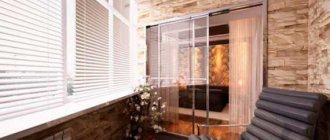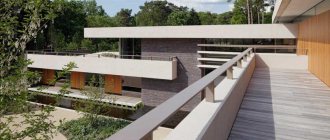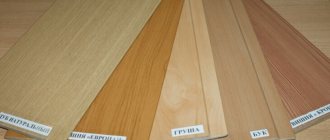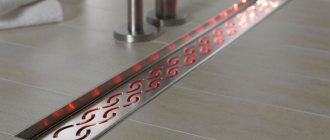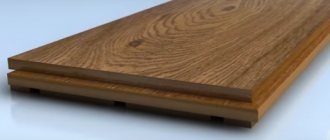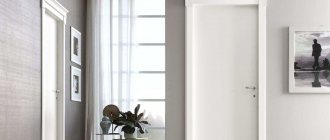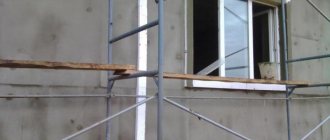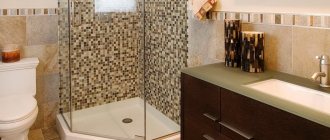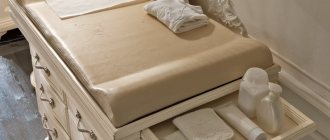Choosing insulation for the balcony floor
The balcony is a remote structure. It is connected to the house only by the slab on which it is located. This is how it differs from a loggia, which additionally has 3 main walls and can be insulated with any materials. The balcony cannot be additionally loaded. Since the work is planned to be done with your own hands, the insulation must meet the following requirements: be light in weight, easy to cut, and easy to install. Expanded polystyrene and mineral wool meet these requirements.
Expanded polystyrene for thermal insulation of floors on the balcony
You can insulate the floor on the balcony with your own hands using polystyrene foam and penoplex.
Both materials belong to expanded polystyrene, but differ in technical characteristics. Polystyrene foam consists of many bubbles isolated from each other. The ratio of polystyrene and air in the insulation is 2 to 98. The size of the bubbles is from 5 to 15 mm.
Polystyrene foam is most often used to insulate floors on balconies due to its low cost. It is also worth noting its other positive characteristics:
- Low thermal conductivity - 0.028-0.034 W/m*K;
- Low water absorption - 4%;
- Low vapor permeability - 0.23 Mg/(m*h*Pa);
- Density - 15-35 kg/m3;
- Compressive strength - at least 5-20 kPa;
- Temperature range - -50+75°C;
- Service life is up to 15 years.
Penoplex is produced by extrusion.
It differs from ordinary polystyrene foam not only in technical characteristics, but also in appearance. Penoplex has a structure that is uniform throughout the thickness of the slab, so it is easy to cut: a fine-toothed hacksaw is enough to cut the insulation without waste. Consists of loosely connected balls. When cutting with any tool, it crumbles, cracks, breaks. The technical characteristics of penoplex are more attractive than those of polystyrene foam:
- Thermal conductivity is lower - not higher than 0.028;
- Water absorption - no higher than 0.4%;
- Vapor permeability - 0.015;
- Density - 27-47;
- Compressive strength - 50 kPa;
- Temperature range - -50+75°C;
- Service life - up to 50 years.
Penoplex is more expensive than polystyrene foam, but its technical characteristics are more attractive.
Both materials are flammable (G3 and G4), so they are not recommended for use unprotected (under concrete screed or plaster is allowed). Important! If the balcony is on the south side, play it safe and insulate the balcony with mineral wool. The operating temperature range of polystyrene foam is small.
Mineral wool for insulating balcony floors
There are several varieties of this insulation.
These are stone wool, slag wool and glass wool made from quartz. The technical characteristics of the material are varied. Mineral wool does not burn. The basalt variety has an upper operating temperature threshold of 1000°C. In this case, it will only melt. Basalt wool comes in different densities. The higher this indicator, the stronger the material conducts heat. Available in rolls, mats, slabs, as well as a foil version.
Characteristics of basalt wool:
- Thermal conductivity - 0.034-0.043;
- Water absorption - 1-2%;
- Vapor permeability - 0.3;
- Density - 10-159;
- Compressive strength - up to 80 kPa;
- Operating temperature range - 200-1000;
- Service life - up to 50 years.
Basalt wool is an ideal insulation material for balcony floors. The only thing is that it weighs significantly more than polystyrene foam.
Foil insulation for thermal insulation of the floor on the balcony
There are several varieties of such materials - based on polystyrene foam, polyethylene foam and mineral wool. The thickness of such insulation is less than their non-foil counterparts. They work on a double principle:
- The insulation itself does not allow cold into the room.
- The foil layer pushes heat back into the room, working on the principle of a thermos.
The price of foil insulation depends on the quality of the foil.
The thicker and stronger it is, the more expensive the material. To insulate the floor on a balcony, an excellent option would be combined insulation: polystyrene foam/penoplex/mineral wool plus foil insulation based on polyethylene foam (penofol). This material has the smallest thickness. Layed on top of the main insulation, it will do an excellent job of pushing heat back into the room. Important!
Choose materials for floor insulation on the balcony from trusted manufacturers. Do not buy from markets where storage conditions may be violated.
Floor insulation material – top sellers
A selection of the most popular materials for insulation will please those who do not intend to make expensive repairs on the balcony.
Related article: Plastic door device: characteristics
Insulation with expanded clay
Floor insulation materials:
- Expanded clay. Lightweight, durable material with excellent thermal insulation characteristics, very convenient to use. The price issue is more than acceptable; in short, expanded clay has an excellent reputation.
- Styrofoam . Usually, when insulating a floor with polystyrene foam, it must be laid in several layers. This is, perhaps, all the difficulties in working with him. The material is inexpensive and easy to use. There are two ways to insulate the floor with foam plastic: using wooden logs, and leveling the balcony slab with a cement screed.
- Mineral wool . Leader in demand due to ease of use and efficiency. When insulating the floor with mineral wool, a method based on a wooden structure (lag) is used.
- Penoplex . A relatively young material that can be used to insulate the floor efficiently and fairly quickly. Installation is simple, everything is attached with your own hands according to a well-thought-out scheme, thanks to which there is no need to foam the gaps between the plates - there will simply be no gaps.
- Penofol. Not only can it be used to insulate a floor, this material is multifunctional. It replaces both the vapor barrier layer and the waterproofing layer. That is, in essence, it is complex insulation, the most modern insulation for balcony floors.
There is another alternative option - we insulate the balcony floor in a high-quality and modern way, which means using a “warm” floor system, the description of which will still be returned.
Technology of thermal insulation of the floor on the balcony with polystyrene foam
Despite their flammability, polystyrene foam and penoplex remain priority materials. The technology for laying them on the floor is the same and has some subtleties. For rigid installation, purchase only polyurethane compounds or dry cement-based mixtures. If the glue contains organic substances, the polystyrene foam will dissolve. To minimize cold bridges, lay the insulation in two layers and seal the seams with metallized tape or silicone sealant. Optimal combination: polystyrene foam + foil polyethylene foam. An electric heated floor is often laid on top of such a “pie”.
Tools and materials for thermal insulation of the floor on the balcony
To work, you will need thermal insulation material (foam plastic or penoplex), foil insulation (penofol, foil insulation), glue (if rigid installation is expected), a wooden beam to create a base for the future floor and a set of tools, additional materials and useful items:
- A broom for cleaning the balcony slab from debris and dust.
- Vacuum cleaner for final dust removal of the surface.
- Self-tapping screws, drill-driver.
- Construction level - the balcony slab must be checked for evenness. If the deviations are large, you will have to do alignment.
- Dry mixture for self-leveling cement screed if the floor on the balcony is uneven.
- Fine-toothed hacksaw for cutting polystyrene foam.
- The spatulas are wide and serrated.
- Needle roller for leveling cement screed and for rolling insulation boards.
The work procedure is divided into 3 stages: preparatory, installation of insulation and laying of the finishing coating.
Preparatory work before floor insulation
This stage includes removing debris and dust, checking the level of the base and pouring a concrete screed, if required:
- Clear the balcony of foreign objects, remove debris and dust.
- Check the base for levelness. Knock down obvious bumps, cement the depressions with mortar. If there is a large difference in height, it is better to pour a thin cement screed. To do this, set the boundaries of the future floor along the perimeter of the balcony slab - lay a border of one brick on the cement mortar (use hollow bricks, place them with the spoon side on the base).
- Prepare a container for water and a bag with dry screed. Pour the mixture into the water and stir using a mixing attachment attached to a drill. Let stand for 5 minutes and stir again.
- Pour the mixture onto the prepared base and smooth it with a needle roller so that there are no bubbles. The thickness of the screed is flush with the curb.
- Allow the mixture to harden and gain working strength.
After this, you can begin insulation. Immediately before installation, you need to cut the foam/penoplex. Place the insulation on a flat, durable surface, mark the pieces that need to be cut. Further work can continue according to two scenarios - glueless (floating) installation and adhesive (rigid) installation.
Floating installation of polystyrene foam on the floor
This installation of expanded polystyrene is much simpler, and the process itself is cleaner, since it does not require working with adhesive mixtures.
Procedure for floating installation:
- Lay a beam with a cross-section of 15 x 15 cm along the perimeter of the balcony. Before laying, treat the wood with any composition that protects against rotting (antiseptic) and dry.
- Place a waterproofing film on the floor. Thick polyethylene will do. This is especially important if the floor on the balcony is insulated with polystyrene foam. Penoplex does not require waterproofing, since its water absorption is minimal.
- Secure the film to the beam with a construction stapler. The waterproofing must completely cover the tree.
- Lay the first layer of insulation. Place the sheets like a brick bond, the vertical seams should not coincide.
- Tape the seams with metallic tape.
- Lay a second layer of insulation. There should be a whole slab of foam plastic/penoplex above each seam.
- Tape the seams with metallic tape.
- Cover the material with foil insulation - penofol, foil-isolon. Insulate the joints with construction tape.
- Apply the finishing coat. The distance between the foil and the finished floor must be at least 3 cm.
Adhesive installation of polystyrene foam on the floor
The procedure for hard installation is somewhat different.
You will need to prepare cement-based foam/penoplex glue in accordance with the instructions. You can use polyurethane, but it will cost much more. Procedure for adhesive installation:
- Install the base for the future floor (frame made of wooden beams 15 x 15 cm around the perimeter of the balcony).
- Roll the foam/penoplex boards with a needle roller.
- Mix the adhesive mixture with water.
- Using a wide spatula, apply adhesive to the entire surface of the slab, removing excess with a notched spatula.
- Place the first slab in the corner of the balcony and press well.
- Continue with the rest of the insulation, following the principle of brick bonding.
- To seal the seams between the slabs and the timber, use silicone sealant.
- Place foil insulation on top and seal the joints with metallized tape.
- Make a finished floor from a tongue and groove board and varnish it. The insulation of the floor on the balcony with penoplex/foam plastic is completed.
Important! If the balcony is not heated, insulation is unlikely to help achieve a comfortable temperature on it. The best option would be to install an electric heated floor on top of such thermal insulation. But this will require the help of professionals.
Floor insulation based on logs
The first layer that will fall on the concrete floor is waterproofing. To do this, use glassine. Do not forget that you should always lay a waterproofing layer with a small margin in length and width.
After this comes preliminary insulation in the form of thin insulation; sometimes two or three layers are required to better insulate the floor.
Each layer of insulation is treated with foam at the joints and directly along the perimeter of the balcony.
And now it’s worth taking a closer look at laying the lags. You will need a wooden beam 5 cm high and 5-7 cm wide. These bars are laid across the balcony in increments of 50 cm. Do not place the outer bars close to the wall, leave a distance of 5-7 cm.
The thicker the insulation, the lower the thermal conductivity
The bars are installed on small spacers made of plywood pieces; if you do without them, the bottom layer of insulation will be pressed through. It is also necessary to put insulation between the joists, usually five-centimeter polystyrene foam. Lay it close to the joists; if there are gaps, use foam.
Before starting work, be sure to treat the wooden material with an antiseptic.
By the way, by installing joists you can not only better insulate the floor, but also level it. But what material to choose for insulation is further.
Thermal insulation of the floor on the balcony with mineral wool
Such thermal insulation does not require a perfectly flat base, so the preparatory stage comes down to only cleaning the balcony slab from debris and dust.
You will also need to level out obvious pits and bumps. Additionally, you can impregnate the concrete base with waterproofing mastic or use the classic option - dense polyethylene, which is much cheaper. The procedure for insulating the floor on a balcony with mineral wool:
- Install timber around the perimeter on the prepared base.
- Put down the joists. Make a step along the width of the insulation boards. The material should fit tightly between the joists, with some space. This will help avoid cold bridges.
- Lay the waterproofing film over the joists and secure it with a stapler.
- Insert insulation between the joists. Use a rolled type of basalt wool, cut exactly to size (according to the width of the balcony).
- Place a vapor barrier membrane on top, secure it, and seal the joints with construction tape. You can replace the vapor barrier membrane with thin foil insulation.
- Seal the joints of the foil insulation with metallized tape.
- Install the sheathing on top. The thickness of the bar is at least 3 cm.
- Lay down the finishing layer of tarmac boards. Cover the finished floor with varnish.
Important!
Use basalt wool to insulate the floor on the balcony. It has the lowest water absorption coefficient. Watch a video about thermal insulation of the floor on a balcony: Knowing how to insulate the floor on a balcony, you can easily turn this room into a cozy office, winter garden or small greenhouse. Be sure to first calculate the required insulation thickness for your region, consult with specialists about the additional load on the balcony slab and its maximum value.
Preparatory work
The first thing to do is to glaze the loggia, close it along the contours if it is not already glazed and open. This stage of work includes glazing the loggia with double-glazed windows. We recommend using two or even three-chamber ones. This is the best option for saving heat on the loggia. Traditional windows will not be able to provide you with complete protection from winds, drafts and atmospheric influences.
After the glazing is completed, we carefully clean the floor of the loggia from dirt. The next thing to do is to seal all the cracks that exist after installing double-glazed windows, small cracks with polyurethane foam , and large cracks with foam. fill the holes with crushed stone , or, as a last resort, with broken bricks and cement mortar.
, electrical sockets are also installed . If in the future you plan to install electric heated floors.
But remember that after you insulate the floor, it will definitely rise 7 cm , so when you install utility networks, take this into account.
If you plan that your loggia will be an extension of the room or kitchen, then take care of additional heaters.
Methods of floor insulation
If plywood on joists (the floor insulation method discussed above) is the most common technology, only screed can compete with it.
Screed options are varied and depend on your taste and budget.
Screed involves obtaining a kind of thermal insulation sandwich, the layers of which are: concrete balcony slab - thermal insulation - screed - finishing coating.
The algorithm for insulating a floor with a screed will be as follows:
- Thermal insulation will be, for example, polystyrene foam. If you don’t want to save money, you can also use expanded polystyrene, which is, roughly speaking, a more advanced type of foam. It is laid in two layers with obligatory overlapping of joints.
- The damper dividing tape is glued along the perimeter of the balcony. This, while insulating the floor, is done so that the screed does not touch the walls. Instead of tape, if there is none, small pieces of foam are often taken.
- Fill the screed . It is not advisable to do it yourself; there is a high risk that the homemade mixture will not work. It is safer to buy a special dry screed mixture in a store from a manufacturer with a good reputation.
- If the “warm floor ” system is used, then it, of course, is laid before pouring. Standardly this is a heating cable and reinforcing mesh.
- The primer begins after the screed has dried. The next layer is a finishing coating, for example, porcelain stoneware.
An alternative to this option is a dry screed, which can also be used to insulate the floor well.
This method is based on a gravel bed on which floor elements made of gypsum fiber sheets are laid. Although, of course, if we insulate a concrete floor this way, you risk being in the minority - dry screed is less popular.
Related article: What to hang instead of curtains on windows?
